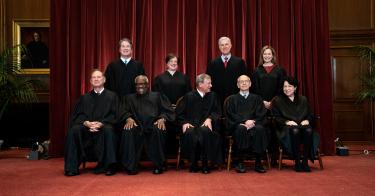The three words that best describe the Supreme Court’s decisions this term are text, history and tradition. If that’s one word too many, try this: Originalism Rules! And that’s a good thing.
The court considered several important constitutional cases this term. The split in most of these cases was six-to-three, with the “conservative” justices in the majority and the “liberal” justices in dissent.
In the biggest case, Dobbs v. Jackson Women’s Health Organization, a five-justice majority ruled the Constitution has no right to obtain an abortion. This overturned Roe v. Wade (1973) and Planned Parenthood v. Casey (1992).
Nearly 50 years ago, Justice Byron White, in his Roe dissent, wrote that the errant ruling represented an “exercise of raw judicial power.” Similarly, John Hart Ely, an eminent scholar who supported abortion rights, stated that Roe was “not constitutional law and g(ave) almost no sense of an obligation to try to be.”
>>> 5 Monumental Cases That Highlighted the Supreme Court’s 2021-2022 Term
Those views were reflected in the majority opinion for Dobbs, written by Justice Samuel Alito. He noted that the right to an abortion is not in the Constitution’s text, nor was it part of our nation’s history or traditions. Indeed, virtually every state outlawed abortion when the Constitution and the 14th Amendment were ratified.
The court also decided on an important Second Amendment case, NY State Rifle & Pistol Assoc. v. Bruen. Justice Clarence Thomas wrote the six-to-three majority opinion, striking down a New York law requiring law-abiding citizens who passed a background check to demonstrate a “special need”—beyond a general desire to defend oneself—before being permitted to carry a firearm outside the home.
The court said that such a restriction was not supported by—drumroll please—either the amendment’s text or the nation’s historical traditions. The court further stated that the amendment was the “product of an interest balancing by the people” and that it was improper for a court to engage in a “judge-empowering interest-balancing inquiry” once the protections of the amendment had been properly invoked.
In an important religious liberty case, Kennedy v. Bremerton School District, Justice Neil Gorsuch wrote the six-justice majority opinion ruling that a school violated the free exercise and free speech rights of a high school football coach when it fired him for offering a silent post-game prayer at midfield. The court relied upon—you guessed it—“historical practices” and the “original meaning” of the First Amendment’s text in reaching its decision.
The court also finally declared that the court’s much-criticized three-part test for analyzing Establishment Clause cases, promulgated in Lemon v. Kurtzman (1971)—which Justice Antonin Scalia once described as “some ghoul in a late-night horror movie that repeatedly sits up in its grave and shuffles abroad, after being repeatedly killed and buried”—was indeed dead.
The court also sided with religious adherents in other significant religious liberty and free speech cases, including Carson v. Makin, Shurtleff v. City of Boston, and Ramirez v. Collier. Senator Ted Cruz also won a significant victory against the Federal Election Commission in which the court, again by a six-to-three vote, held that an FEC rule violated the First Amendment rights of candidates wishing to make personal loans to their own campaigns to engage in pure political speech.
And in NFIB v. OSHA, West Virginia v. EPA and Alabama Assoc. of Realtors v. HHS, the court (again via 6-3 votes) held that separation-of-powers principles require Congress to speak clearly before an administrative agency consisting of unaccountable bureaucrats can exercise nearly unlimited power over decisions of great “economic and political significance.”
>>> Supreme Court’s Ruling in West Virginia v. EPA Delivers Win for Self-Government, Affordable Energy
In his dissenting opinion in the infamous case of Dred Scott v. Sandford, Justice Benjamin Curtis stated: “When a strict interpretation of the Constitution, according to the fixed rules which govern the interpretation of laws, is abandoned, and the theoretical opinions of individuals are allowed to control its meaning, we have no longer a Constitution; we are under the government of individual men who, for the time being, have power to declare what the Constitution is according to their views of what it ought to mean.”
During this momentous term, the court made great strides toward interpreting the Constitution with fidelity and restoring the rights of all Americans to govern themselves—with the exception of those few individual rights that are delineated in our Constitution or firmly rooted in our nation’s historical traditions—debating, persuading and deciding contentious issues directly or through their elected representatives.
In terms of interpreting and adhering to the Constitution, I give the court an “A-plus.”
This piece originally appeared in Inside Sources




